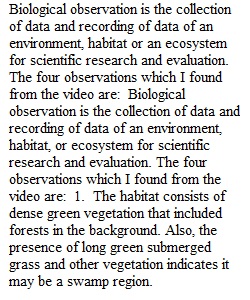


Q DOWNLOAD THE UNIT 1 EXPERIMENT ANSWER SHEET! Download DOWNLOAD THE UNIT 1 EXPERIMENT ANSWER SHEET! How to Proceed • Read through the introductory materials below. • Open the Unit 1 Experiment Answer Sheet and complete the following Experiment exercises this unit: o Experiment 1 Exercise 1 - The Scientific Method (~30-45 min) o Experiment 1 Exercise 2A - pH of Common Materials (~30-45 min) o Experiment 1 Exercise 2B - pH and Buffers (~45-60 min) • Save your completed Unit 1 Experiment Answer Sheet and submit it no later than Sunday midnight CT. ________________________________________ The Scientific Method - Introduction The Scientific Method is the basis for almost all scientific research. If you click on the Unit 1 Overview page, you can read about how the Scientific Method is conducted. You can also read about the process in your book on pp 14-17. One area of confusion often involves the difference between a hypothesis and a prediction. This is because many people use these terms interchangeably, but in fact, they are different. Here is how your book discerns the two: Hypothesis - an answer to a question or explanation of an observation (p 14). Prediction - an expected outcome if our hypothesis is correct; often worded as “if…then” (p15). The purpose of this first exercise is to have you use the Scientific Method yourself. We will use the following web site. Be sure that you can access it and use it: Glencoe/McGraw Hill. No date. The Scientific Method http://www.glencoe.com/sites/common_assets/science/virtual_labs/ES01/ES01.html (Links to an external site.) When you are ready to begin, use the instructions in the Unit 1 Experiment Answer Sheet and work through the exercise. ________________________________________ pH of Common Materials - Introduction This unit we are also learning about some of the chemistry that is important in biological systems, such as pH. Be sure you have read pp 32-33 in your book and our online lecture this unit before beginning this exercise. The pH scale ranges from 0 to 14; a pH less than 7 is considered acidic and a pH greater than 7 is basic. The pH scale is logarithmic, which means that a solution with a pH of 3 is ten times more acidic than a solution with a pH of 4 and a hundred times more acidic than a solution with a pH of 5. Acids and bases are not necessarily a bad thing. Many of the materials that we handle and eat and drink everyday vary in pH. Some of these materials are safe to handle, such as “weak” acids (e.g., soda, coffee). Stronger acids (e.g., battery acid) and bases (e.g., ammonia) can be quite caustic and damaging. One way to measure the pH of liquids is to use pH indicator paper; paper that turns a particular color depending on the pH of the solution. Anyone with a swimming pool or hot tub is probably familiar with such paper. We will use a virtual lab to examine the pH of common solutions that you might have around the house. You will use the following website; be sure you are able to access and use it: Glencoe/McGraw Hill. No date. pH of Common Solutions http://www.glencoe.com/sites/common_assets/science/virtual_labs/E22/E22.html (Links to an external site.) When you are ready to begin, open the Unit 1 Experiment Answer Sheet and follow the instructions to complete this exercise. ________________________________________ Buffers - Introduction As you saw in the previous exercise, the pHs of common solutions vary across the pH scale! Yet our body is constrained to work within a very narrow pH range. Small changes in pH can alter the function of biologically important molecules such as enzymes, by breaking hydrogen bonds and denaturing these proteins. For this reason, in most organisms (such as ourselves), pH is very closely regulated. pH can be kept relatively constant by the use of buffers, chemicals which can absorb or release hydrogen ions to maintain a relatively steady pH. In most vertebrate animals, blood pH must be maintained between 7.35 and 7.45. There are several biological buffers that work to maintain this pH; one of the more important being the carbonic acid - bicarbonate system: H2O + CO2 <--> H2CO3 <--> H+ + HCO3- In the reactions above, the double headed arrows indicate that each step is reversible. If carbon dioxide (CO2) levels increase in our blood, it can combine with water to form carbonic acid (H2CO3), which can break down to form bicarbonate (HCO3-) and hydrogen ions. This would shift the pH towards the acidic end. If the acidity levels become too high, the whole process will reverse, such that hydrogen ions are removed and carbon dioxide is produced; thereby shifting the pH towards the alkaline end. This is only one example of a biological buffer; there are several other systems involved, but they all operate in a similar manner. The purpose of this exercise is to help you understand the chemistry of buffers. Be sure that you have read through the material on pp 32-33 in your book and this unit’s online lecture on The Chemistry of Life. For this exercise, you will use the following website (be sure your speakers are on): McGraw-Hill Education. No date. Buffers Animation. (Links to an external site.) You may need to download and install a plugin to use this simulation, so test this simulation early in the unit in case you run into problems. When you are ready, open the Unit 1 Experiment Answer Sheet and follow the instructions there to complete this exercise. ________________________________________ Unit 1 Experiment Grading Rubric Component Expectation Points Experiment 1 Exercise 1 Demonstrates an understanding of the Scientific Method and an ability to apply it (Table 1, Questions 1-3) 10 pts Experiment 1 Exercise 2A Demonstrates an understanding of pH and how it applies to your everyday life (Table 2, Questions 1-5). 13 pts Experiment 1 Exercise 2B Demonstrates an understanding of pH and the effect of buffers (Questions 1-5) 13 pts TOTAL [[[[[[[ 36 pts PreviousNext
View Related Questions